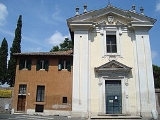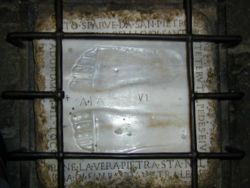
Church of Domine Quo Vadis
Encyclopedia

Rome
Rome is the capital of Italy and the country's largest and most populated city and comune, with over 2.7 million residents in . The city is located in the central-western portion of the Italian Peninsula, on the Tiber River within the Lazio region of Italy.Rome's history spans two and a half...
, central Italy. It is located about some 800 m from Porta San Sebastiano
Porta San Sebastiano
Porta San Sebastiano is the modern name for the ancient Porta Appia, a gate in the Aurelian Wall of Rome, through which the Via Appia, now the Via di Porta San Sebastiano at that location, left the city in a southeasterly direction. It was refortified at the end of the 4th century and was again...
, where the Via Ardeatina
Via Ardeatina
Via Ardeatina was an ancient road of Rome leading to the town of Ardea, after which it is named. Ardea lay 24 miles distant from Rome.-External links:*...
branches off the Appian Way
Appian Way
The Appian Way was one of the earliest and strategically most important Roman roads of the ancient republic. It connected Rome to Brindisi, Apulia, in southeast Italy...
, on the site where, according to the legend, Saint Peter
Saint Peter
Saint Peter or Simon Peter was an early Christian leader, who is featured prominently in the New Testament Gospels and the Acts of the Apostles. The son of John or of Jonah and from the village of Bethsaida in the province of Galilee, his brother Andrew was also an apostle...
met Jesus
Jesus
Jesus of Nazareth , commonly referred to as Jesus Christ or simply as Jesus or Christ, is the central figure of Christianity...
while the former was fleeing persecution in Rome. According to the apocryphal
New Testament apocrypha
The New Testament apocrypha are a number of writings by early Christians that claim to be accounts of Jesus and his teachings, the nature of God, or the teachings of his apostles and of their lives. These writings often have links with books regarded as "canonical"...
Acts of Peter
Acts of Peter
The Acts of Peter is one of the earliest of the apocryphal Acts of the Apostles. The majority of the text has survived only in the Latin translation of the Vercelli manuscript. It is mainly notable for a description of a miracle contest between Saint Peter and Simon Magus, and as the first record...
, Peter asked Jesus, "Lord, where are you going?" . Jesus answered, "I am going to Rome to be crucified again" .
History
There has been a sanctuary on the spot since the ninth century, but the current church is from 1637. The current façade was added in the 17th century.It has been supposed that the sanctuary might have been even more ancient, perhaps a Christian adaption of some already existing temple
Temple
A temple is a structure reserved for religious or spiritual activities, such as prayer and sacrifice, or analogous rites. A templum constituted a sacred precinct as defined by a priest, or augur. It has the same root as the word "template," a plan in preparation of the building that was marked out...
: the church is in fact located just in front of the sacred campus dedicated to Rediculus
Rediculus
Rediculus was an ancient Roman divinity. He had a temple near the Porta Capena, as well as a campus sacred to him on the Appian Way.-Origins and nature :...
, the Roman "God of the Return". This campus hosted a sanctuary for the cult of the deity that received devotion by travellers before their departure, especially by those who were going to face long and dangerous journeys to far places like Egypt
Egypt
Egypt , officially the Arab Republic of Egypt, Arabic: , is a country mainly in North Africa, with the Sinai Peninsula forming a land bridge in Southwest Asia. Egypt is thus a transcontinental country, and a major power in Africa, the Mediterranean Basin, the Middle East and the Muslim world...
, Greece
Greece
Greece , officially the Hellenic Republic , and historically Hellas or the Republic of Greece in English, is a country in southeastern Europe....
or the East. Those travellers who returned also stopped to thank the god for the happy outcome of their journey.
The presence of the Apostle Peter in this area, where he is supposed to have lived, appears to be confirmed in an epigraph
Epigraphy
Epigraphy Epigraphy Epigraphy (from the , literally "on-writing", is the study of inscriptions or epigraphs as writing; that is, the science of identifying the graphemes and of classifying their use as to cultural context and date, elucidating their meaning and assessing what conclusions can be...
in the Catacombs of Saint Sebastian that reads Domus Petri (House of Peter). An epigram
Epigram
An epigram is a brief, interesting, usually memorable and sometimes surprising statement. Derived from the epigramma "inscription" from ἐπιγράφειν epigraphein "to write on inscribe", this literary device has been employed for over two millennia....
by Pope Damasus I
Pope Damasus I
Pope Saint Damasus I was the bishop of Rome from 366 to 384.He was born around 305, probably near the city of Idanha-a-Velha , in what is present-day Portugal, then part of the Western Roman Empire...
(366–384) in honor of Peter and Paul
Paul of Tarsus
Paul the Apostle , also known as Saul of Tarsus, is described in the Christian New Testament as one of the most influential early Christian missionaries, with the writings ascribed to him by the church forming a considerable portion of the New Testament...
reads: "You that are looking for the names of Peter and Paul, you must know that the saints have lived here."
The two footprints on a marble slab at the center of the church — nowadays a copy of the original, which is kept in the nearby Basilica of San Sebastiano fuori le mura
San Sebastiano fuori le mura
San Sebastiano fuori le mura , or San Sebastiano ad Catacumbas , is a basilica in Rome, central Italy...
— are popularly held to be a miraculous sign left by Jesus. It is to these footprints that the official name of the church alludes: palmis refers to the soles of Jesus' feet. It is likely that these footprints are actually the draft of an ancient Roman "ex voto", a tribute paid to the gods for the good outcome of a journey.
There was an inscription above the front door on the church's façade which used to say: "Stop your walking, traveller, and enter this sacred temple in which you will find the footprint of our Lord Jesus Christ when He met with St. Peter who escaped from the prison. An alms for the wax and the oil is recommended in order to free some spirits from Purgatory." Pope Gregory XVI
Pope Gregory XVI
Pope Gregory XVI , born Bartolomeo Alberto Cappellari, named Mauro as a member of the religious order of the Camaldolese, was Pope of the Catholic Church from 1831 to 1846...
found the advertising tone of this inscription so inappropriate that he ordered its removal in 1845.
The church is currently administered by priests of the Congregation of Saint Michael the Archangel
Congregation of Saint Michael the Archangel
The Congregation of Saint Michael the Archangel , in Latin Congregatio Sancti Michaëlis Archangeli and also known as the Michaelite Fathers, is a religious order of the Roman Catholic Church founded in 1897 by the Blessed Father Bronisław Markiewicz, a Polish priest from Miejsce Piastowe, Poland...
.

